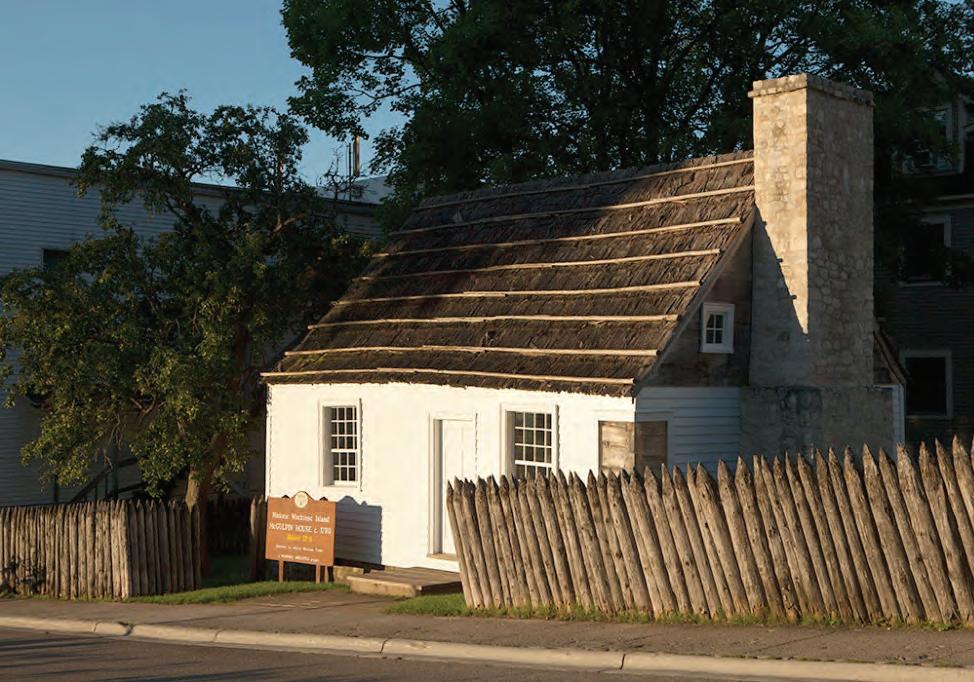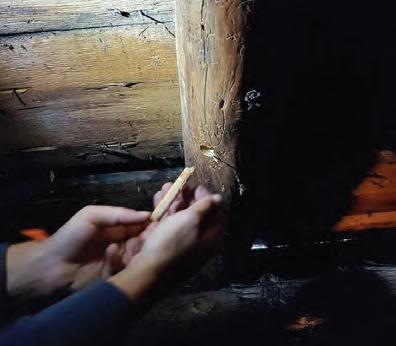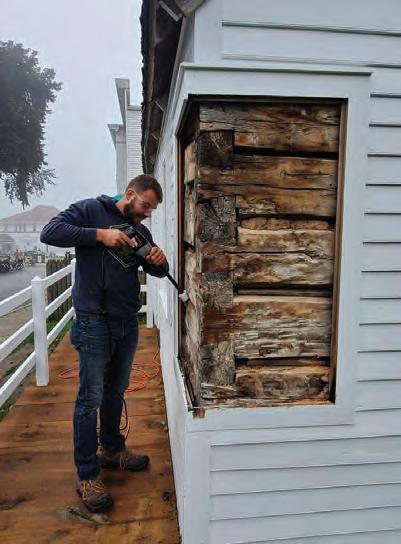
4 minute read
SOLVING THE MCGULPIN MYSTERY
by CHASE EDWARDS
Mackinac island visitors strolling by McGulpin House would notice a squat, whitewashed structure with the simplest of lines, like a Monopoly playing piece; nothing overtly intriguing, nothing grand like the island’s iconic cottages and hotels.
But for more than two centuries, the homely little cottage that sits at Market and Fort streets has held its secrets tight to its ancient timbers. Until now.
Certainly, historians could date it to the 18th century given its French Canadian–style construction typical to that era—squared horizontal pine logs and a steeply pitched roof covered in cedar bark that naturally sheds rain and snow. But when exactly was it built? Date the house (now known as the McGulpin House and managed by Mackinac State Historic Parks) precisely, and you’d have an intimate window into Mackinac Island in the 1700s. And what a dramatic and colorful century that was. Way back then, the Straits of Mackinac was a wild frontier where Native Americans, the French, British and finally Americans warred over possession of the lucrative Great Lakes fur trade.
Historians postulated that the home could have been built as far back as 1740. If that were the case, it would have been built across the Straits at Fort Michilimackinac most likely by the French. And how would it have gotten to the island? The British (they took control of the Straits in 1780) could have brought it across the ice along with most of Fort Michilimackinac as a defensive move at the end of the Revolutionary War. Or was the McGulpin House built later, after America won the Revolution and the island became part of the new country?
In the end, it was the tree rings in those old timbers that gave up the date. Recently, Zachary Merrill of Great Lakes Dendrochronology determined the home’s construction as late summer or early fall of 1790. Merrill likes to say, “Trees don’t lie, but oral histories do.” In order to accurately date the McGulpin House, core timber samples of the house had to be compared to another building with a known date. “There has to be enough overlap between one chronology and another for it to statistically match,” Merrill explains. Samples from the McGulpin House matched up with another dendrochronologist’s research on Beaver Island at an old Mormon print shop.
Merrill’s study of the McGulpin House started in 2021 by collecting 19 samples focused on the roof timbers. He began with samples from the roof because it was the most noninvasive area of the house. “I didn’t want to affect the appearance or architecture,” Merrill explains. He took each sample back to his office where he sanded them down with 1,000 grit sandpaper and measured the rings using digital measuring software. Some tree rings are so small that had Merrill tried counting the rings in the field—before sanding down the samples—his count could have been off by more than 100 years.
That first summer, Merrill ended up with an inconclusive date for the McGulpin House. “The dating was there,” Merrill says, “but it wasn’t there enough. I figured with more samples I could get a positive date, something I could stand behind.” So, the following year Merrill took samples from every area of the house he could reach without causing visual damage. He then compared the new samples to the old samples and came up with what he describes as a “robust chronology” for the house, concluding it was built in 1790.
Flashback To 1790
The Revolutionary War has been over for seven years and President George Washington has recently given the first State of the Union Address in the young country’s then capital, New York City. Thanks to the Treaty of Paris seven years before, King George is to keep his hands off the 13 colonies as well as any land east of the Mississippi and north of Florida to the Great Lakes, including Mackinac Island, which had just squeaked under the northern boundary of the new country. But the Brits are taking their sweet time leaving the island, including Fort Mackinac that sprawls defensively along the limestone bluffs. We can only speculate that one Brit went so far as to build himself a new house, his axe ringing out defiantly into the silence of the clear Straits of Mackinac air.
With nary an American citizen on the island to tattle to the authorities in the new country, the Brit likely got away with his big trespass—at least for six years. The Americans took over Fort Mackinac in 1796 and pushed the British out—but not for good, as it turns out. The Brits retook the fort during the War of 1812. After America won that war in 1815, the Brits were pushed out, for the last time.
End of story? Not quite. There’s much historians still don’t know about the McGulpin home. Did the builder flee to Canada, sail back across the pond to his Mother Land or did he switch his allegiance to the new country? And for that matter, what was the Brit’s name? It wasn’t McGulpin. He was a baker for the American Fur Company, who purchased the home in 1817. Secrets all, that the old house has yet to give up.
Visit The Mcgulpin House
History lovers make the most of their island time with a Historic Downtown Mackinac pass, which includes entry to the nearby Biddle house (featuring interactive demonstrations and the Mackinac Island Native American Museum),The Richard & Jane Manoogian Mackinac Art Museum and Mackinac at Work at the Benjamin Blacksmith Shop. All open May 12 through Oct. 8. From June 3 to Aug. 19, this ticket also includes the American Fur Co. Store & Dr. Beaumont Museum and McGulpin House.
A new McGulpin House exhibit opened this summer and includes a short video program about architectural styles on the island as well as updated educational panels providing context in terms of what was happening on the island in 1790. mackinacparks.com













